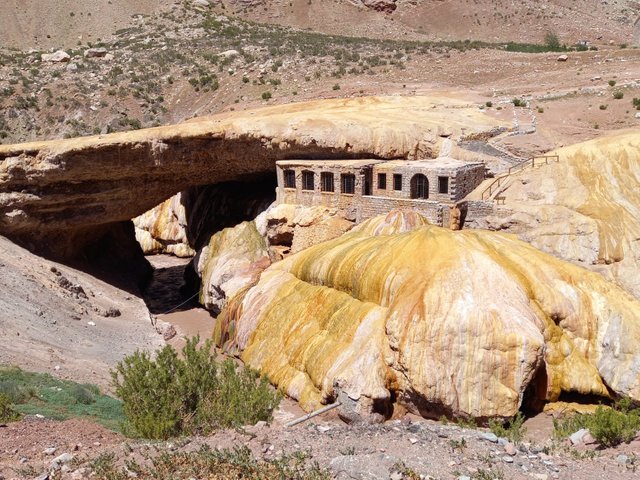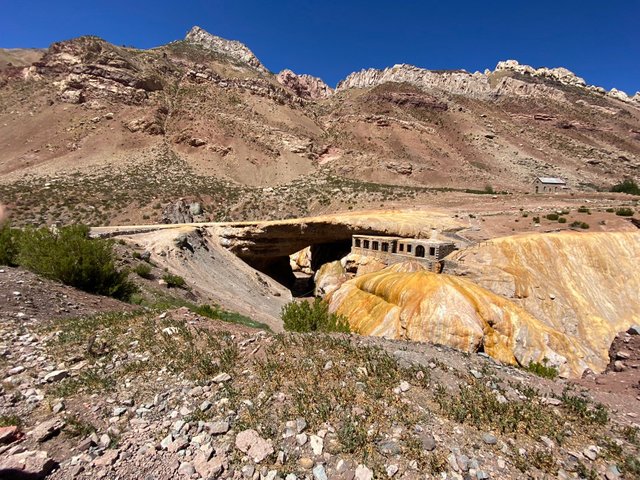[#Club100] Puente del Inca-Mendoza Argentina: Leyenda e Historia [ESP-ENG]
El Puente del Inca es una de esas maravillosas creaciones naturales que se encuentra en la Provincia de Mendoza, Argentina, cuya leyenda e historia es digna de recordar.
Behind the natural monuments that exist in the world, there is a legend that precedes them as well as a written history that helps us to understand much of the mystery that surrounds them.
The Puente del Inca is one of those marvellous natural creations located in the Province of Mendoza, Argentina, whose legend and history is worth remembering.
Puente del Inca-Mendoza Argentina: Legend and History



Repentinamente uno de los vasallos del Monarca le sugirió que la llevaran al lejano Sur en la Cordillera, para que fuera sumergidas en las aguas curativas que alli se encontraban, siendo esa su unica alternativa para salvarlo.
El Monarca de inmediato planificó todo y armo una comitiva conformada por sus mejores guerreros y guardianes y salieron rumbo a las aguas termales.
The Inca Bridge is preceded by the legend of its origin, which dates back to the Inca Empire, where it is said that the heir to the Inca throne was very ill and the town's sorcerers were unable to find a cure for the ailment that afflicted him.
Suddenly one of the vassals of the Monarch suggested that she be taken to the far south in the Cordillera, to be immersed in the healing waters that were found there, that being her only alternative to save him.
The Monarch immediately made plans and assembled a retinue of his best warriors and guardians and set out for the hot springs.

Cuando llegaron al lugar se dieron cuenta que tenian que pasar al otro lado y atravesar un rio que estaba muy fuerte debido a un alubion que habia sucedido.
Los guerreros del Monarca decidieron hacer un puente humano , en muestra del amor y admiración que le tenían al Monarca, donde cada uno de ellos se entrelazaron y abrazaron de tal forma que le permitieron al Monarca pasar caminando sobre sus espaldas con su hijo cargado hasta el otro lado del rio para poder llegar a las aguas termales curativas.
Y asi fue logró pasar con su hijo al otro lado del rio y fue entonces cuando con los curanderos que lo acompañaban procedieron a sumergirlo en las aguas.
Luego de ello el monarca se devolvió a agradecerle a sus guerreros por lo que habian hecho, cuando se percató que todos habian muerto petrificados por el frio de las aguas del rio.
When they reached the place they realised that they had to cross to the other side and cross a river that was very strong due to a landslide that had happened.
The Monarch's warriors decided to make a human bridge, in token of the love and admiration they had for the Monarch, where each of them intertwined and embraced in such a way as to allow the Monarch to walk on his back with his son on his back to the other side of the river to reach the healing hot springs.
And so it was that he managed to pass with his son to the other side of the river and it was then that with the healers accompanying him they proceeded to immerse him in the waters.
After that the monarch returned to thank his warriors for what they had done, when he realised that they had all been petrified to death by the cold waters of the river.

El hotel resultó un verdadero atractivo para el turismo, sin embargo debido a la falta de mantenimiento de las vias aledañas , los aludiones amenazaron durante varios años al hotel, hasta que una noche de Agosto de 1965, un aludes arrasó con el hotel en su totalidad dejando solo la capilla de la iglesia que aún existe en la actualidad.
In relation to the history of the Puente del Inca, the famous Hotel Balneario Puente del Inca was built there at the beginning of the 19th century, the aul had a boom during several decades due to the growing railway activity in the area and the rise of the trans-Andean railway.
The hotel was a real attraction for tourism, however due to the lack of maintenance of the surrounding roads, landslides threatened the hotel for several years, until one night in August 1965, an avalanche destroyed the hotel in its entirety, leaving only the chapel of the church that still exists today.

Puente Del Inca (tarjeta postal 1900-1910) . Fuente/Source

Todas las imágenes son de mi propiedad, pertenecen al Albun familiar.
All images are my property, they belong to the family Albun.
#Club100
Esta publicación esta configurada con 15% de beneficiario a @writingnreviews

Thank you very much.
Amiga me encantó este post!! Mendoza es mi ciudad :D!! Amo Puente del Inca! Y extraño un montón esa montaña!
Gracias por compartir y hacerme viajar a mi tierra un ratito :D
Hola amiga @belenguerra
Que bueno que te gustó la publicación.
Gracias por tu visita y comentario.
Abrazos!
Hi